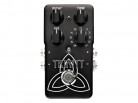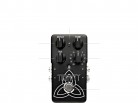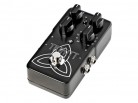First Impressions
The pedal itself is surprisingly small. Its shorter than other pedals - I actually had to make a spacer to fit under it to bring it up a little so that it didn't sit lower than the other pedals on the board. The case itself is a very attractive black with a screenprint Trinity logo. The foot switch is cleverly located inside this logo. Four knobs on top and a small switch round out the package. Three of the knobs are typical - Decay, Tone, and Mix. The fourth knob is where it gets interesting. 11 settings which have abbreviations are controlled by this knob. The abbreviations are a little confusing at first but really I just used my ear to work through the settings. The small switch controls the delay time between the direct sound and the reverb effect. The pedal features stereo input and output and on the top where there is the 9v power input there is a micro USB port. Wait - micro USB? One of the best features of this pedal is that you can change some of the effects with a computer - model them to your needs and skip the factory setup. Better yet you can download sound files of some of your favorite artists. More on that later.
Playtime
Rather than add the pedal to an effect chain I put it between the amp and guitar. In this case its the guitar into the Trinity into my Quilter Aviator with its built in reverb turned off. No other effects. The pedal itself can accept a 9v battery but with varying performance as a battery wears down I went with an external power source instead. While handling the pedal I discovered that the micro USB plug is not a standard micro USB that can work with cell phones, tablets, and just about every other accessory out there. I got the pedal from a friend which wasn't a big deal as the owner's manual is in PDF format online but this odd cable didn't come with the pedal and there is no mention in the documentation as to whether it is provided with the pedal. I'ts not as big of a deal as possible but if you want to do real time editing of the sound files you'll need this cable. If all you want is to download files to try it isn't a big deal. More on that later.
The Trinity Reverb is actually based on TC's Hall of Fame Reverb. According to TC's site the Trinity came about when , wait, I'll just let them explain it:
"Trinity Reverb was originally meant as a limited-run, exclusive thing for ProGuitarShop. But due to the demand from guitarists far and wide, we've now made this beauty available worldwide. After all, we all deserve a little exclusivity in our life!"
As far as I can gather two settings were changed for this version of the pedal. They are labeled as E1 and E2 which are abbreviations for Ethereal 1 and 2. TC markets this pedal for the rock musician but having played with the two Ethereal settings I'd say those really don't lean towards rock. So the question becomes what is the difference between the Trinity and the Hall of Fame? To show their incredible similarity I found this video on Youtube.
One could say there is a slight difference but then one could also probably get dead exact tone with simple small knob adjustments. Perhaps there is a small amount of difference built into them but based on their similarity I don't think I would make a purchase decision based solely on this unless I could test them myself side by side in a store. What should be immediately obvious in a couple of the examples is that there is a touch of chorusing going on with some of these settings. This is awesome - its very hard to balance a chorus pedal and reverb effect - but having them in one unit fixes a lot of the difficulty and I really like what I'm hearing in these tone samples. What's also nice about this video despite its length is the fact that you can hear each individual setting. Obviously adding gain or overdrive will change this.
One area I'm going to take exception with this pedal is the silk screening. All the settings are abbreviated - so I found myself thinking that Ch meant chorus. No it means church which isn't anything like chorus. Some of the abbreviations look like they came straight off the periodic table. On the Hall of Fame every setting is written out. Perhaps this was a compromise since Ethereal 1 and Ethereal 2 probably wouldn't have fit - but Ether 1 looks a lot better and gives an idea what to expect without being E1. This is a case of don't fix what isn't broken. I found my first stabs at this pedal (remember I didn't have the manual in front of me) were confusing and frustrating.
On the video you can fast forward to about the 15 minute mark to see what exactly the Ethereal settings are all about. I like them - much more handy than the settings that exist on the same spot on the knobs on the Hall of Fame in my opinion. The last setting on the dial is TP which is actually Tone Print and has nothing to do with toilet paper. Tone Print is the ability to import those sound files into the pedal. Of course if you have the right micro USB cable you could do that but TP is more useful. Download the TP app to your phone or tablet, or even your computer. Next find that file you like. In this case you'll be browsing Hall of Fame files since the Trinity isn't mentioned specifically. I found a beautiful Steve Vai "Ocean Sound" file - you can watch videos within TP to get an idea of what you may get. Next cue up the install option - raise the volume on the guitar and phone and place the phone next to the pickup on the guitar. Here's where I'm going to suggest you mute the strings with your left hand. Next hit install and sonic-ally the file is installed into your pedal via the guitar. It's that easy and means you can try a ton of files quickly. How did it work? Easily and accurately. Sadly I don't have Vai's setup so the sound I got was weak and didn't seem focused like the video demonstrated. One sound I really like was the Guitar Center file. This is a full on in your face reverb that likes blues, jazz chords, all the way to distorted rock. Now that is a useful file. Have a favorite artist who you know uses the Hall of Fame - try their files on the Trinity and go. Just remember that your mileage will vary depending on your setup.
How does it work with other pedals?
Being that this pedal develops complex tones within itself I expected some hit or miss results. First I tried a chorus pedal in front - and found that both the reverb and chorus just seemed to be stamped out on a lot of the settings. Sound cancelling? Different brands hating each other? I don't know but a chorus in front of this pedal is a really bad idea. One pedal was a Japanese Boss and the other the Dutch TC. They could've had wonderful tea and chocolate together but instead one showed up to the event in a Tokyo boardroom and the other was busy enjoying a beautiful picnic in the countryside. Chorus behind the Trinity led to some odd sounds but again they seem to cancel each other to a degree. Seeing how this pedal can chorus within itself it made my chorus unnecessary but I was hoping for a wild sound.
Overdrives and distortion pedals love to be behind this pedal. In front of it with an overdrive I wasn't as happy and distortion before reverb led to some jarring sounds - like a torn bass cabinet cone. Dial those pedals way back if you want them in front. Now one thing to remember is that this pedal has stereo out. I setup the aviator on the left and then my Tone Block on the right with a Carvin 2x12 Cabinet with Celestion V30's. I put one overdrive onto each side - a tube based to the Aviator and a digital based unit to the Tone Block. How did it work? Heavenly. With the guitar volume rolled far back I got nice chords. As the volume increased I got nice breakup of the V30 cab and the Aviator stayed relatively tight - just what I wanted. With volumes on the amps increased and the guitar full open I got some amazing tones. Very complex and pleasing. I got a true stereo rig that sounded a lot like two guitarists playing together. This means I can record both and then in the final mix make them equal or lean towards clean or break up. Or I could remove one tone for sections of a song.
Conclusions
The Trinity to my ear isn't a follow up to the Hall of Fame so much as the better version. Much like a Corvette is great but a Z06 is better. We could make analogies to cars from everywhere but you get where I'm going. One thing that sets these pedals ahead of their competition is that they are just as goof for bass players. Tons of bass files are available to try - and they don't sound bad on guitar or vise versa.
Would I change anything? The silk screening around the selector knob really annoys me. I actually found I had to make a cue card with the setting names and stuck it to my pedal board. The odd micro USB cable also comes to mind. If you want to use the Windows or Mac based editor software you'll need to get this cable. I recall these connectors on old cameras so maybe you already have one around. Watch the video with Steve Vai and you can see how the engineer is editing with the software (or a similar software). Its a shame since so many devices are now using the standard micro USB cable.
Despite that I've never seen a reverb pedal that can go all the way into chorus territory and then even go into some delay territory. Don't get rid of your delay pedal but do get rid of that chorus pedal.













